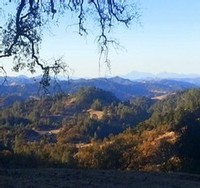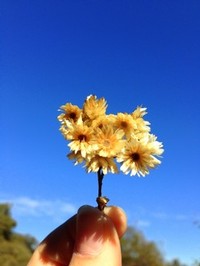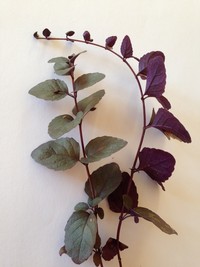On The Hunt for Botanicals
We had a rushed and exhausting harvest this year; it arrived early and was particularly relentless. In other years we've picked grapes for a few days, then had a few days "off," then picked some more--harvest usually strolls along like that for about 6 weeks. But this autumn, we picked day after day after day, followed by night after night in the winery. I hardly had time to feel sad about my youngest child's move to UC Santa Barbara. Thankfully she was very organized about gathering the essential goods and packing. We dropped her off on a stunningly warm and beautiful Sunday in late September.
 Angeline came home for the Thanksgiving holiday Tuesday night, and Wednesday afternoon we went for a long stroll on the west side of the ranch. We were searching for botanicals for the 2013 Flora Rose' label. We had a few plants in mind and set out to find some good samples to photograph. I had Laird's small Nikon and Angie had her trusty iphone. Last year's winning picture of Bay Laurel for our Rose' label was taken with her phone--technology is pretty amazing. We were hoping to get pictures of plants in the field and to collect some for more photographing against a white background at home.
Angeline came home for the Thanksgiving holiday Tuesday night, and Wednesday afternoon we went for a long stroll on the west side of the ranch. We were searching for botanicals for the 2013 Flora Rose' label. We had a few plants in mind and set out to find some good samples to photograph. I had Laird's small Nikon and Angie had her trusty iphone. Last year's winning picture of Bay Laurel for our Rose' label was taken with her phone--technology is pretty amazing. We were hoping to get pictures of plants in the field and to collect some for more photographing against a white background at home.
So about wine labels: every label must be approved by the federal government before it can be printed and applied to a bottle of wine. Naturally, organizing our work around the approval of the sluggish Bureau of Alcohol and Tobacco Tax and Trade (TTB) can be frustrating. Usually we set our two bottling dates (early April, late August) months in advance, and work backwards from there to get the label ready. There is often a backlog at the Bureau, anywhere from several weeks to several months, making label approval one more thing our winemaker Shannon has to worry about. For most of our varietals, the label changes are very minor: just updating the year on the front label, the percentage of alcohol, and the percentage breakdown of any blends. But with the Flora Rose' we change the picture and the description on the back label each vintage, and are almost always surprised that it is once again that time of year--a scramble to select a botanical for the label.
Throughout the year I try to take pictures of wildflowers so that we have plenty to choose from; we have a pretty good selection on the computer. But this year we had other plans. There aren't many flowering plants in the winter, but we knew of a few that we particularly love. Pearly Everlasting (anaphalis margaritacea) blooms in summer and bears many clusters of small white blossoms. They dry out in the fall and are a sturdy, pretty, cream-colored dry flower (hence the everlasting). They also have a distinctive butterscotchy, brown sugar fragrance when you crush the flowers in your fingers. It's a food plant for butterflies and was used by Native Americans as a salve for burns. Angeline and I found several specimens on the rocky, sagebrush trail to our springs. We experimented with photographing the plant as it stands, and holding it up against the blue sky.
We were also looking for Yerba Buena (Clinopoduim douglasii), a native mint plant that grows under oaks and alongside shady creeks, low and runner-like in the rich soil. Yerba Buena is the common name, which means good herb in Spanish. The first we came upon were dried and gray; the drought has definitely affected the plant life on the ranch this year. But once we got to our springs, where the sunlight barely filters in and lush ferns and madrone grow, we found some beautiful samples. The leaves are almost heart shaped, and a vivid purple on the underside. The plant has a strong minty scent and was used medicinally by natives. Laird and Nathan had been cutting wood earlier in the week, beneath an oak, and Laird had waxed poetic about the cool sunny day, with the scent of crushed mint wafting up from beneath their boots. That's what gave me the idea to hunt this plant down and possibly feature it on our label.
While at the springs we checked the level of Lake Rufus, which was quite low. This lake (a small pond, really) was named after our now departed chocolate lab, who spend many summer up there while Laird and the boys developed our water system. Rufus was always game for a wet fetch or swim. The water level was way down, but even so Arrow, our tireless fetcher, could not be persuaded to get his pretty white feet wet. There were dozens of fat goldfish swimming around, the survivors of a bucket of cheap goldfish that Angie and her cousin doled out in every trough and pond one long ago summer. They are surprisingly hearty.

Comments
Commenting has been turned off.Keep up to date on the latest wine releases, events, and promotions and get 10% off your next order.

